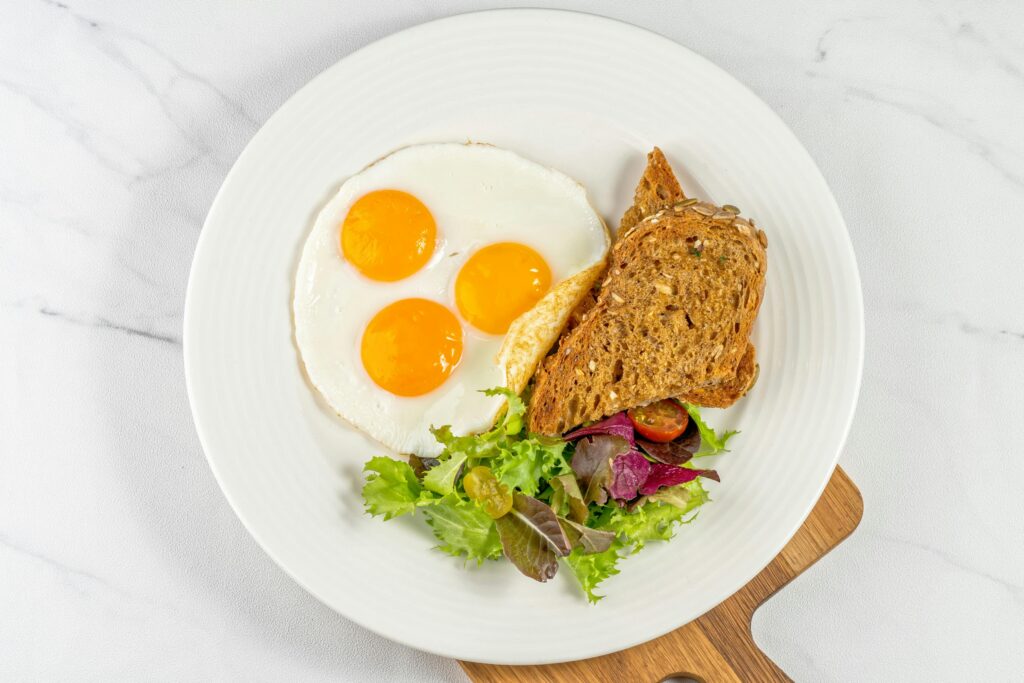If you’re looking for how to reduce belly fat, you’re not alone. In this guide, we’ll cover 10 effective ways to reduce belly fat and boost overall health, from mindful morning routines to high-intensity workouts and nutrition tips. Belly fat can be challenging to lose and often requires a balanced approach combining diet, exercise, and lifestyle adjustments. Follow these sustainable, practical steps, and you’ll be on your way to achieving a leaner waistline and a healthier body.
Table of Contents
ToggleStart with a Mindful Morning Routine
Why it matters:
How you start your morning can set the tone for the rest of the day. By practicing a mindful routine, you’re not only activating your metabolism but also reducing stress—a key factor in belly fat accumulation. Stress releases cortisol, a hormone known for promoting fat storage around the abdomen.
Actions:
- Drink Warm Water with Lemon: Starting the day with a glass of warm lemon water hydrates the body, flushes out toxins, and helps reduce bloating. Lemon is high in vitamin C, which is essential for fat oxidation, while warm water aids digestion by stimulating gastric juices.
- Practice 5 Minutes of Breathing Exercises: A few minutes of deep breathing or mindful breathing exercises can lower cortisol levels, keeping your mind calm and focused. This routine also curbs the “stress eating” habit that many people struggle with.
Pro Tip: If you want to go further, try a 5-minute morning stretch routine, which awakens the muscles and helps release any tightness from sleep.

Balance Your Macros for Optimal Fat Loss
Why it matters:
Reducing belly fat is not just about cutting calories; it’s about eating the right types of foods. When you balance your intake of protein, healthy fats, and carbohydrates, you ensure that your body receives the nutrients it needs for energy, metabolism, and muscle building.
Actions:
- Increase Protein Intake: Protein is key for maintaining muscle mass while losing fat. It also has a higher thermic effect than carbs or fats, meaning your body uses more energy to digest it. Opt for lean sources like chicken, turkey, eggs, tofu, and legumes.
- Opt for Complex Carbs Over Simple Carbs: Foods like white bread, pasta, and pastries cause rapid spikes in blood sugar, leading to insulin release. This hormone can encourage belly fat storage. Replace them with complex carbs such as quinoa, oats, and whole-grain bread, which digest more slowly and keep you feeling full longer.
- Include Healthy Fats: Fats don’t automatically make you fat. Healthy fats from avocados, nuts, seeds, and olive oil can actually help you lose weight by keeping you satiated. They also aid in nutrient absorption and hormone balance, both crucial for reducing belly fat.
Pro Tip: Try to make protein a consistent part of every meal to help regulate your appetite throughout the day.

Prioritize Fiber and Hydration for Gut Health
Why it matters:
Fiber helps digestion and reduces bloating, which can instantly make your stomach feel flatter. Fiber also regulates blood sugar, which plays a role in managing insulin levels and thus prevents excess fat storage around the belly.
Actions:
- High-Fiber Foods: Load up on fiber-rich foods like vegetables (especially leafy greens and cruciferous veggies), fruits, and whole grains. Fiber helps you feel full, controls cravings, and encourages better digestion.
- Stay Hydrated: Often, the body mistakes thirst for hunger, leading to unnecessary snacking. Drinking adequate water (around 8 cups per day) not only keeps you hydrated but also supports the metabolism of fat. Staying hydrated also prevents water retention, which can make you feel bloated.
Pro Tip: Incorporate chia seeds and flaxseeds into your diet; these are high in soluble fiber and help reduce abdominal bloating.

Incorporate Resistance Training to Boost Metabolism
Why it matters:
Building lean muscle through resistance training is one of the most effective ways to increase your resting metabolic rate, meaning you’ll burn more calories even at rest. Muscle tissue burns more calories than fat tissue, and adding muscle helps your body use energy more efficiently.
Actions:
- Strength Training 3x a Week: Include compound exercises like squats, deadlifts, and lunges, which work multiple muscle groups at once. These exercises burn more calories than isolated exercises and strengthen the core as well.
- Focus on Core-Strengthening Moves: Exercises like planks, Russian twists, and leg raises strengthen your core muscles, helping to define your waistline. Core exercises also improve posture, which can make your stomach appear flatter.
Pro Tip: Aim to progressively increase the weights or resistance as you get stronger to continue building muscle and burning fat.

Add HIIT Workouts for Efficient Fat-Burning
Why it matters:
High-Intensity Interval Training (HIIT) is known for its “afterburn effect,” where your body continues to burn calories even after the workout. HIIT is effective in targeting stubborn fat areas, including the belly.
Actions:
- 20-Minute HIIT Routine: A quick routine consisting of 30 seconds of high-intensity exercises (like jumping jacks, mountain climbers, or burpees) followed by 15 seconds of rest can maximize calorie burn.
- Mix Cardio and Strength HIIT Movements: Alternate between cardio moves like sprints and strength moves like squats or push-ups for maximum fat-burning.
Pro Tip: Start with just one HIIT session a week if you’re a beginner, as it’s intense on the body.

Get Quality Sleep to Support Fat Loss
Why it matters:
Sleep plays a major role in hormone regulation, which impacts appetite and cravings. Studies show that insufficient sleep increases ghrelin (hunger hormone) and decreases leptin (satiety hormone), making it harder to resist sugary, high-calorie foods.
Actions:
- Aim for 7-8 Hours of Sleep: This optimal range allows the body to rest and recover, which is essential for metabolism and fat loss.
- Establish a Calming Night Routine: Try to avoid screens an hour before bed, read a book, or listen to calming music to prepare your body for restful sleep.
Pro Tip: Try using an eye mask or blackout curtains to create a dark sleeping environment, as light can disrupt sleep quality.

Reduce Processed Foods and Sugar
Why it matters:
Processed foods and added sugars are high in empty calories and often lead to weight gain, particularly around the abdomen. Added sugar causes blood sugar spikes and crashes, leading to cravings for more sugary or high-calorie foods.
Actions:
- Swap Sugary Drinks for Herbal Teas or Infused Water: Instead of soda or juice, try drinking herbal teas or water infused with fruits and herbs like lemon and mint. This can satisfy your taste buds without unnecessary sugar.
- Choose Whole Foods: Replace packaged snacks with whole foods like fruits, nuts, and yogurt. Whole foods contain natural fibers and nutrients that help keep you full.
Pro Tip: When grocery shopping, check ingredient labels. Avoid products with sugar listed among the first three ingredients.

Embrace Stress-Relief Practices
Why it matters:
Chronic stress triggers cortisol production, which is associated with abdominal fat storage. Incorporating stress-relief techniques not only reduces cortisol but also enhances your overall quality of life.
Actions:
- Practice Yoga or Meditation Daily: Even 10-15 minutes of yoga or mindful breathing can calm the mind and reduce stress.
- Take Regular Breaks Throughout the Day: Stepping away from work or household tasks every couple of hours gives your mind a reset and prevents burnout.
Pro Tip: Try progressive muscle relaxation, a technique that involves tensing and relaxing each muscle group to relieve stress.

Track Your Progress Beyond the Scale
Why it matters:
Weight on the scale isn’t the only measure of success. Tracking inches lost, energy levels, and how you feel can provide a more complete picture of your progress.
Actions:
- Measure Your Waistline Weekly: Tracking inches around your waist can give you a better idea of fat loss than just weight.
- Keep a Journal: Recording your mood, energy, and progress can be motivating and help you stay consistent.
Pro Tip: Take progress photos every two weeks to visually see your changes over time.

Stay Consistent and Celebrate Small Wins
Why it matters:
Belly fat reduction is a slow process. Staying motivated through small successes can help maintain momentum.
Actions:
- Set Achievable Milestones: Celebrate each milestone, like completing a week of workouts or cutting sugar for a month.
Visualize Your Goals: Keep a visual reminder of why you started to stay focused.
Closing Remarks
Reducing belly fat is not just about achieving a certain look—it’s about creating a healthier, more balanced lifestyle that benefits your body and mind. By focusing on nutritious foods, effective exercises, and mindful habits, you’re setting yourself up for sustainable success. Remember, the journey to wellness isn’t a race; it’s about making small, consistent choices that lead to lasting change. Celebrate each milestone, no matter how small, and be kind to yourself along the way.
For a deeper approach to managing stress and connecting with your body, check out our guide on Somatic Yoga. Somatic yoga combines movement and mindfulness, helping you release stress and build a stronger mind-body connection—perfect for those looking to enhance their wellness journey.
Here’s to a healthier, stronger you—inside and out!




I am really loving the theme/design of your weblog. Do you ever run into any browser compatibility issues? A few of my blog readers have complained about my site not working correctly in Explorer but looks great in Firefox. Do you have any advice to help fix this issue? http://www.kayswell.com
Very nice post. I just stumbled upon your weblog and wished to say that I’ve really enjoyed browsing your blog posts. After all I’ll be subscribing to your feed and I hope you write again soon!